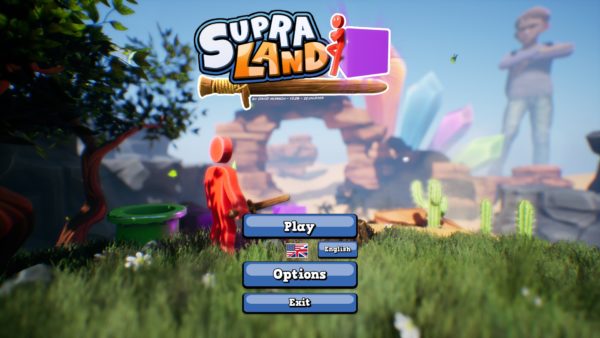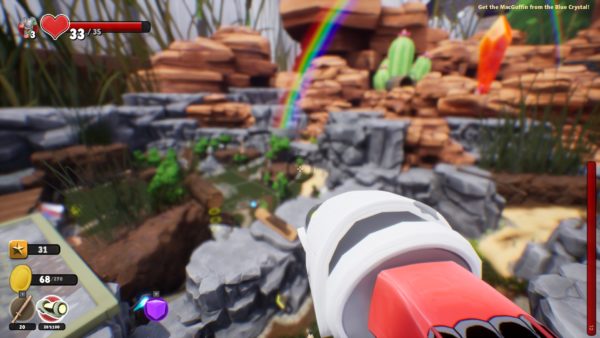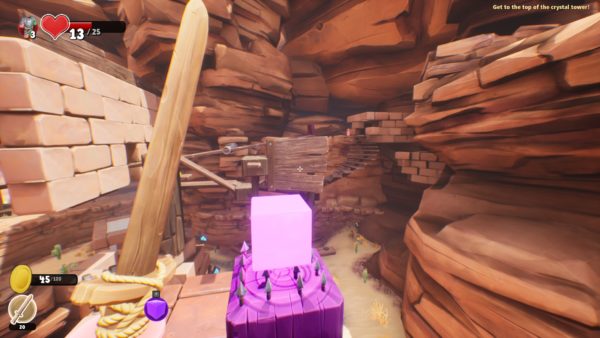The one thing I’ve always hated about most Metroidvania games is when they show you something that you’re not able to access with your current abilities. Often this manifests extremely early on as you explore the level only to find there’s a part you can’t get to with no indication of when you’ll get the requisite ability to explore there. Quite often those areas aren’t even necessary for you to explore, just a bonus or something, so their inclusion is merely to draw you back to earlier levels. To be fair there are some examples where this is done well, the revisiting of the level being driven by story or other mechanical elements, and for those I have far more leniency. I tell you this mostly preface my thoughts on Supraland as it’s this particular mechanic, as well as a handful of other issues, that made this a game I didn’t want to play past a couple hours.

The Steam store page for Supraland proclaims, among many other things, that the story is “minimal” and that’s absolutely true. Whilst the premise is quite cool, all the characters are toys in a kid’s sandpit, the plot itself is ridiculously basic: you’re the red guys and the blue guys have shut off your water supply and it’s up to you to turn it back on. However to actually get to the blue guys you have to make your way through numerous different challenges, many of which will require you to upgrade your equipment and skills in order to do. I’ve read elsewhere that there’s a little more too the story later on in the game but it does nothing to expand upon it at all, save for having little dialogue instances between NPCs which have nothing to do with the plot at all.
The graphics of Supraland are heavily stylized and simplified, giving it a very cartoony feel. The developers have managed to avoid the typical Unreal engine game feel, keeping the use of specularity to a minimum. There’s a heavy use of depth of field which is supposed to give you the feeling that you’re a very small being in a large world. To some extent this works however it can have the effect of simply making everything disorienting like in the screenshot below. The issue here is, of course, perspective as whilst the game touts that it only has a tiny map of 9m2 that’s somewhat meaningless if you’re scaled down in size. So try as you might to make it feel like a small world with tiny people it’s going to end up feeling just like normal anyway, no matter how much you try to use depth of field or tilt shifting to change that.

Supraland bills itself as a combination of games like Portal, Zelda and Metroid which is horrendously disingenuous as it’s much more akin to the run of the mill indie puzzle platformers we’ve seen many of over the past decade. To be sure there are elements that you could say are borrowed from each game: the platforming from Portal (although that’s a stretch), the semi-open worldedness of Zelda games and the reexploration mechanic from Metroid. Realistically it’s just a bog standard first person puzzler with a tacked on RPG progression system. There’s really nothing wrong with that but the appeal to authority of titles with much greater pedigrees is what’s getting me. Honestly I was going to write this off as just your average indie puzzler until I reread the Steam page but now I feel compelled to point out all the faults given that it thinks it’s a combination between 3 of arguably the most influential titles in the puzzler space.
The combat is simple and implemented poorly. There’s really no nuance to it at all with enemies just running directly at you or standing dead still whilst they shoot from you at a distance. There’s also no way to block so you’ll likely end up dying to the first enemies since their melee range is the same as yours and there’s nothing you can do to stop them from hitting you. Once you get the gun you can basically just kite everything around but in its default form it’s annoyingly slow. Not that you’ll be wanting for upgrades for long though, even with rudimentary exploration you’ll be unlocking the upgrades in no time flat, even with the requisite barrel running task that serves no other purpose but to burn more of your time. But let’s not judge the game based on the one attribute which it doesn’t trumpet the most, let’s take a look at its puzzles and exploration.

The puzzles are incredibly simple, most of which you’ll solve pretty much straight away without too much of a thought. Others are easily solvable with emergent behaviours that the developer hasn’t taken into account, like being able to bypass entire sections of the game by walking on terrain that hasn’t been properly walled off. This only gets more ludicrous the more mechanics you have access to, giving you all sorts of means to break the game and bypass core game mechanics. This would be fun if it weren’t for the fact that it also means that there’s a certain level of gank to puzzles you can’t bypass, necessitating replaying certain puzzles over a few times in order to get them to complete properly.
Exploration is rewarded, although most of the time it’s just a few coins hidden around a corner or somewhere else rather obvious. The other parts are, of course, hidden behind mechanics you don’t yet have access to, something which will necessitate you trudging all the way back through the levels in order to get back to it. There is a rudimentary fast travel system however you can’t access it from a map (I don’t believe there is a map, actually) and it takes a good 20 seconds for it to travel you somewhere. This makes retreading ground a pretty annoying experience and, given that most of those hidden rewards are just basic upgrades, there’s no real compelling reason to do so.

It’s for these reasons that I didn’t find myself drawn back to playing Supraland after the first night I sat down with it. The fact that most of the work was done by a single developer is commendable but the marketing of it could not be further off the mark. The game is simplistic in all the wrong places, making combat a chore, puzzles easily waltzed through and the prospect of going back to retread old ground something I don’t think any sane player would want to do. Of course the reviews on Steam paint a much different picture and so it’s quite possible I’m on the wrong side of the fence for this, but in all honesty I simply cannot see what others find enjoyable in this game.
Rating: 6.5/10
Supraland is available on PC right now for $28.95. Total play time was 2 hours with 27% of the achievements unlocked.



